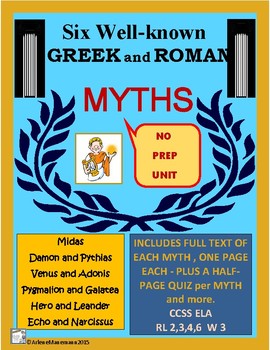MYTHS - Six Greek and Roman Myths with Complete Text & Quizzes|Distance Learning
- PDF
Description
This mythology unit has the full text of six myths - two Greek myths and four Roman myths. These are great to use by themselves, in literature centers, as supplements to your mythology unit, or to fulfill CCSS ELA Reading Literature #9 which requires comparing two different pieces of literature with the same theme.
Included are:
- Six Myths - the full text of each; each on one page - two Greek and four Roman; see preview for the list, please.
- A half-page quiz for each: five true/false questions plus one requiring a written response.
- Student handout with directions for writing their own myth, which includes stationery for writing and a rubric.
- Two puzzles - word search and spelling ladder.
- A bonus puzzle for early finishers - Greek and Roman Gods and Goddesses.
Please see preview for more details.
I also sell a product for a Navajo Origin Myth





